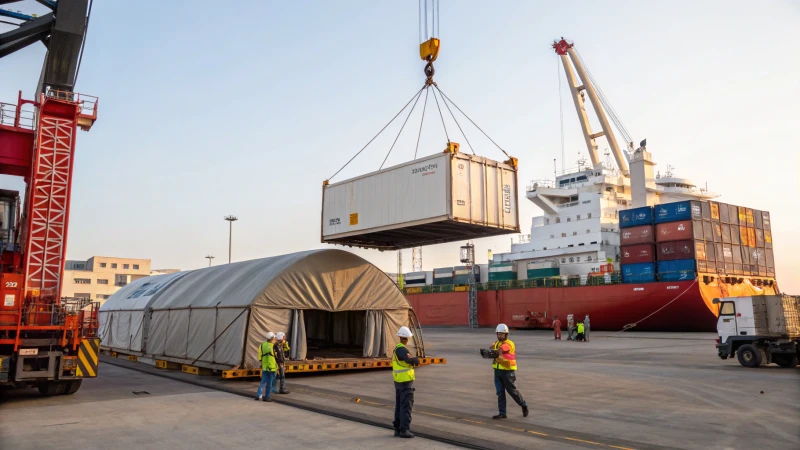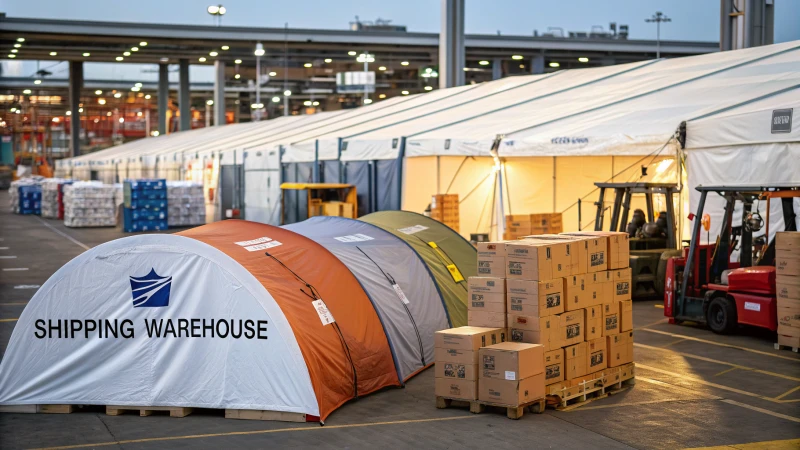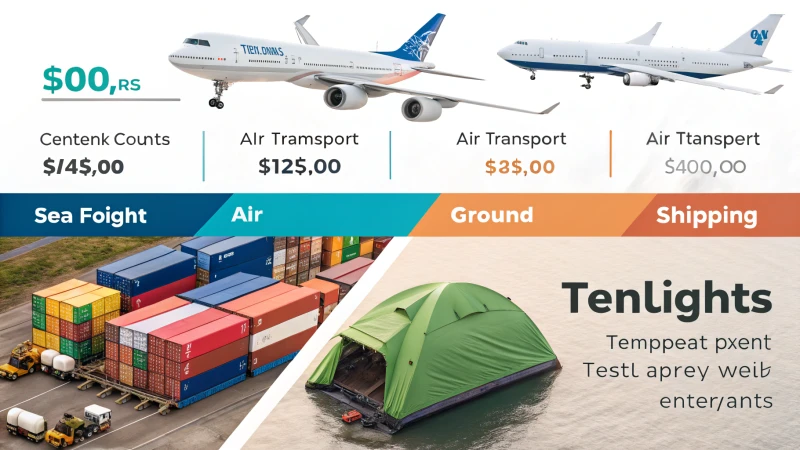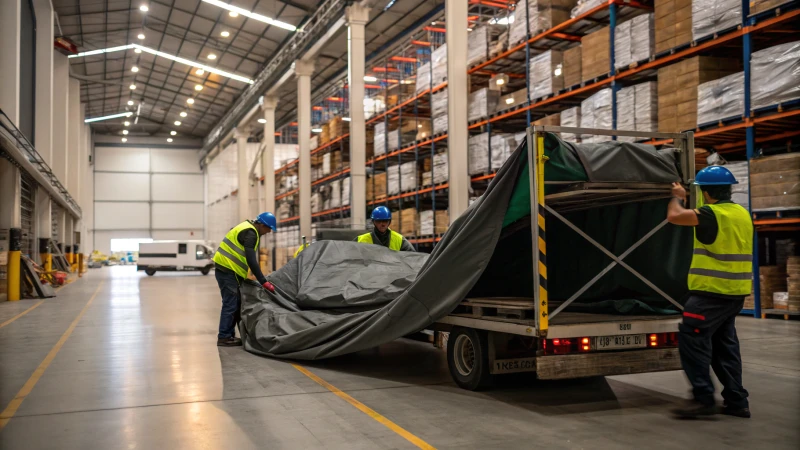
Shipping a warehouse tent overseas feels like navigating a maze of costs and decisions.
Shipping a warehouse tent internationally involves costs influenced by the tent’s size, weight, destination, and shipping method. Typically, sea freight can range from $1,000 to $5,000, whereas air freight is pricier. Thoughtful planning and selecting the right logistics partner can help manage these expenses efficiently.
I remember the first time I shipped a massive tent overseas. The sheer scale of it made me feel like I was sending a small house across the ocean! It turned out to be a learning experience in managing costs effectively. From figuring out whether sea or air freight was more viable to dealing with customs at each port, each step was a lesson in logistics. Knowing the specifics, like how size and weight impact the final bill, gave me the confidence to make informed decisions and ultimately save on unnecessary expenses.
Sea freight for tents always costs under $1,000.False
Sea freight ranges from $1,000 to $5,000 for warehouse tents.
Air freight is generally more expensive than sea freight.True
Air freight costs more due to faster delivery and fuel expenses.
How Do Tent Size and Weight Influence Shipping Costs?
Ever tried to ship a tent and got hit with unexpected costs? It’s all about size and weight!
Tent size and weight are key factors in shipping costs. Larger tents take up more space, leading to higher freight charges, while heavier tents increase fuel consumption and handling fees. Understanding these elements can help you make cost-effective shipping decisions.

The Impact of Tent Dimensions on Shipping Costs
When I first started shipping tents, I was caught off guard by how much the dimensions influenced the costs. The larger the tent, the more space it occupies in a shipping container or truck, which directly translates to higher fees. Picture trying to squeeze a 20×40 meter tent into a container—it’s like trying to fit an elephant into a suitcase! This is why a 10×20 meter tent1 might be more economical to ship.
| Tent Size | Space in Container | Estimated Cost |
|---|---|---|
| 10×20 meters | Less | $1,000–$2,500 |
| 20×40 meters | More | $2,500–$5,000 |
The Role of Tent Weight in Shipping Expenses
I remember feeling the weight—literally—of my first steel-framed tent shipment. Heavier tents not only take up more space but also require more fuel and handling effort. A tent weighing around 4,000 kg can cost a fortune if shipped by air freight.
| Tent Weight | Shipping Method | Estimated Cost |
|---|---|---|
| 1,000 kg | Sea Freight | $1,000–$2,500 |
| 4,000 kg | Air Freight | $20,000+ |
Packaging Efficiency and Its Financial Impact
I once packed a tent so efficiently that it saved me about 15% on shipping costs! Compact packaging helps reduce space usage, leading to lower shipping fees and a smaller carbon footprint.
Some packing methods2 can save up to 15% of shipping expenses by optimizing container usage.
Additional Factors Influencing Costs
Beyond size and weight, choosing the right shipping method is crucial. Sea freight is usually more budget-friendly for larger shipments compared to air freight, which is quicker but much pricier. Once, I chose sea freight for a non-urgent delivery, and it made a significant difference in cost.
Consider shipping to accessible ports over inland locations to further cut down on expenses. For instance, sea freight3 works wonders for bulkier items that aren’t time-sensitive.
Understanding these factors has helped me tremendously in managing my logistics effectively. Making informed choices about tent specifications and shipping options not only saves money but also streamlines operations.
Larger tents always cost more to ship than smaller ones.False
Cost depends on multiple factors like weight and packing efficiency.
Sea freight is cheaper than air freight for heavy tents.True
Sea freight is generally more economical for large, heavy items.
How Does Shipping Destination Influence Costs?
Ever tried to ship a tent overseas and felt overwhelmed by the costs?
Shipping destination significantly impacts costs due to distance, import duties, port accessibility, and regional regulations. For cost-efficient shipping, consolidating shipments and choosing major ports can help reduce expenses.

Distance and Its Impact
I remember the first time I had to ship a tent from China to Europe. The cost was surprisingly high due to the distance. It turns out, the farther your shipment travels, the more you pay for fuel, labor, and time. For someone like me who often deals with international logistics, understanding how shipping rates4 vary with distance and transportation modes has been crucial.
Import Duties and Taxes
Every country has its own set of import duties, which can really stack up. Once, I sent a batch of tents to the US and was caught off guard by the 2.5% duty fee, different from what I experienced shipping to Canada, where it’s 6.1%. Knowing these rates helps me better plan for such expenses.
| Country | Import Duty Rate |
|---|---|
| USA | 2.5% |
| Canada | 6.1% |
| EU | Varies by state |
Port Accessibility
Choosing the right port can make a big difference. I learned this the hard way when a shipment intended for an inland location required additional road transport, hiking up the cost unexpectedly. Shipping to well-connected ports often reduces these extra expenses. More on efficient shipping routes5.
Regional Regulations
It’s like navigating a maze sometimes! Each region has its own import regulations, adding layers of complexity and cost. Partnering with knowledgeable logistics providers has been my saving grace in managing these challenges.
Cost-Saving Strategies
I’ve found that consolidating shipments is one of the smartest ways to save money. By bundling orders into one container, I cut down on per-unit costs significantly. And let’s not forget the importance of working with experienced logistics providers6, who ensure compliance with all those tricky regional regulations.
In essence, understanding these variables has helped me choose the most economical shipping strategies based on destination. It’s all about planning ahead and making informed decisions.
Longer shipping distances increase costs.True
Shipping over greater distances requires more fuel, labor, and time, raising costs.
All countries have the same import duty rates.False
Import duties vary by country, affecting the total shipping cost differently.
Which Shipping Method Is Most Cost-Effective for Tents?
Navigating the world of shipping can feel like untangling a mess of ropes. From hefty sea containers to zippy air freight, each method has its own quirks.
For large tents, sea freight is generally the most cost-effective method due to its ability to handle bulky, heavy shipments at lower costs compared to air freight.

Understanding Shipping Costs
Having been in the tent business for a while, I know just how much these shipping costs can vary. The size and weight of your tent, where it’s headed, and any additional services you might need all play a role.
| Factor | Description |
|---|---|
| Size & Weight | Larger tents require more space, impacting cost. |
| Destination | Remote locations may incur higher costs. |
| Additional Costs | Insurance and customs can add to overall expenses. |
Comparing Shipping Methods
-
Sea Freight
If you’re like me, managing large shipments regularly, sea freight is the go-to option. It offers the most economical rates for bulk shipments, which is perfect when I’m shipping out those big wedding tents or industrial setups. A typical 20ft container can range anywhere from $500 to $2,000 depending on the route and distance7. This makes it ideal for companies like mine that prioritize cost savings over speed.
-
Air Freight
Now, there have been times when I’ve needed something shipped fast—perhaps for an urgent client request. In such cases, air freight, though pricier (costing between $3–$8 per kilogram), becomes necessary despite being less viable for heavier shipments like tents. It’s perfect for those "need-it-yesterday" situations, but it’s important to weigh the air transport8 costs against your timeline needs.
-
Road Transport
Road transport comes into play when delivering from ports to inland destinations. Costs can vary based on distance and vehicle type. When I ship to locations away from major ports, road transport becomes essential, adding another layer to consider when calculating overall expenses.
Cost-Saving Strategies
- Consolidation: I’ve learned that combining multiple shipments can really help maximize container space and reduce per-unit costs.
- Negotiation: Engaging with freight forwarders is key to securing competitive rates, especially if you’re shipping regularly like me.
- Standard Sizes: Using standard tent sizes that are easier to pack and ship can significantly lower logistics costs.
- Experienced Partners: Working with logistics providers who are familiar with tent shipments and customs regulations can avoid unnecessary delays and costs.
By carefully examining these factors and strategies, businesses like ours can make informed decisions about which shipping method aligns best with their cost-effectiveness goals9. Whether it’s ensuring that stunning pagoda tent arrives just in time for a client’s event or managing bulk shipments efficiently, being strategic about shipping makes all the difference.
Sea freight is the cheapest for large tent shipments.True
Sea freight is economical for bulky shipments, offering lower costs.
Air freight is the most cost-effective for tents.False
Air freight is faster but more expensive, not cost-effective for tents.
What Additional Services Should You Consider When Shipping Tents?
Ever thought about the hidden complexities of shipping a tent?
When shipping tents, additional services like customs clearance, insurance, and specialized packaging are invaluable. They not only safeguard your shipment but also streamline the process, reducing unexpected costs.

I remember the first time I shipped a tent overseas—it felt like orchestrating a miniature logistical symphony. Beyond just getting the tent from point A to B, there was a whole world of additional services that made the journey smoother.
Customs Clearance Assistance
Navigating customs regulations was like trying to solve a puzzle without the picture on the box. But then, I discovered the magic of engaging a customs broker. They handled all the document processing and ensured compliance with local laws, saving me from delays and penalties. Especially with complex shipments, having professional assistance10 was like having a seasoned guide through a bureaucratic maze.
Insurance Options
I learned early on that shipping insurance isn’t just a nice-to-have—it’s essential. One shipment got caught in bad weather, and knowing it was insured gave me peace of mind. Opt for coverage that matches your tent’s value and shipping route. While some carriers offer basic coverage, comprehensive policies can be your safety net. Take a look at different insurance plans11 to see what suits you best.
Specialized Packaging Solutions
I quickly realized that proper packaging was crucial when one of my tents arrived with a few bruises. Now, I always consider crates or reinforced boxes for extra protection. Moisture-resistant materials are also on my checklist to guard against humidity. Check out some packaging solutions12 that can add an extra layer of durability.
Real-Time Tracking Services
There’s nothing like the thrill—and sometimes anxiety—of watching your shipment’s progress in real-time. This service gives you transparency and helps manage expectations, especially for time-sensitive deliveries. Companies like logistics providers13 offer advanced tracking features that I find incredibly reassuring.
Warehouse and Storage Facilities
On occasions where immediate delivery wasn’t possible, temporary storage options came to my rescue. Warehouses near major ports helped cut down on costs related to inland transport delays. It’s worth exploring storage options14 strategically located for convenience.
Freight Consolidation Services
One of my eureka moments in shipping was discovering freight consolidation. By combining shipments, I maximized container use and reduced costs—especially handy when dealing with multiple tents. Partnering with a freight forwarder15 skilled in consolidation can truly optimize your logistics strategy.
| Service | Benefit |
|---|---|
| Customs Clearance | Avoid delays and penalties |
| Insurance | Protects against damage and loss |
| Specialized Packaging | Prevents transit damage |
| Real-Time Tracking | Offers shipment transparency |
| Warehouse & Storage | Provides temporary storage solutions |
| Freight Consolidation | Maximizes container space, reduces costs |
Each service is a cog in the wheel of efficient shipping. By incorporating these into your shipping plan, you’re not just sending off a tent—you’re ensuring it arrives safely and cost-effectively.
Customs brokers prevent shipping delays.True
Customs brokers simplify document processing, ensuring compliance with regulations.
Real-time tracking is unnecessary for tent shipments.False
Real-time tracking provides transparency and helps manage expectations for deliveries.
Conclusion
Shipping warehouse tents internationally involves various costs influenced by size, weight, destination, and shipping method. Sea freight is generally more economical than air freight for large shipments.
-
Learn how different tent sizes affect shipping expenses and the space they occupy in containers. ↩
-
Discover packing techniques that reduce shipping costs by optimizing container usage. ↩
-
Explore why sea freight is cost-effective for large shipments compared to other methods. ↩
-
Explore the key factors that determine shipping costs over varying distances to optimize your logistics strategy. ↩
-
Discover efficient routes to major ports for cost-effective shipping solutions. ↩
-
Understand how partnering with experienced logistics providers can streamline your shipping processes and reduce costs. ↩
-
Explore this link to find detailed information about sea freight pricing, enabling cost-effective planning. ↩
-
Learn about the benefits of air freight for time-sensitive shipments to make informed logistics decisions. ↩
-
Discover strategies to optimize shipping costs for large items like tents. ↩
-
Learn how customs brokers simplify international shipping by handling paperwork and compliance. ↩
-
Explore insurance plans that offer full protection against shipping risks. ↩
-
Discover effective packaging solutions to protect tents during long-distance shipping. ↩
-
Find logistics companies that provide advanced tracking to monitor shipments. ↩
-
Identify storage facilities that offer strategic locations near key shipping hubs. ↩
-
Connect with experts who can help consolidate shipments to save on costs. ↩







